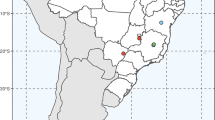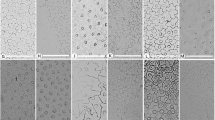Abstract
Complementary to our previous project on the molecular phylogeny of Camphorosmeae, the leaf anatomy of ca. 35 species including all non-Australian and selected Australian species was studied by use of light microscopy. Nine anatomical leaf types were described, compared to previous classifications, and discussed with regard to their putative evolution on the background of phylogenetic trees. Particular emphasis was given to the relationships between the C3 and C4 leaf types: Chenolea type (C3), Eokochia type (C3), Neokochia type (C3), Sedobassia type (C3/C4 intermediate), Bassia prostrata type (C4), B. muricata type (C4), B. eriantha type, B. lasiantha type (C4), Camphorosma type (C4). The main results and conclusions were: (1) Two unusual new C3 leaf types: Chenolea with microfenestrate chlorenchyma, Eokochia with unique complex vascular bundles; (2) Sedobassia interpreted as anatomically C3/C4 intermediate by kranz-like bundle sheath cells is the first C3/C4 intermediate in Camphorosmeae and found in a derived position; (3) Neokochia type detected as the likely starting point for all four C4 leaf types and for the C3/C4 intermediate; (4) hypodermis of C4 types originated from outermost chlorenchyma layer of C3 types and lost multiple times during further evolution; (5) atriplicoid Bassia. lasiantha type without water storage tissue evolved from kochioid B. muricata type; (6) two independent gains of C4 photosynthesis, one in Bassia and one in Camphorosma; (7) depending on the lineage, leaf architecture remains comparatively stable (Australian Camphorosmeae) or shows an unexpected plasticity (Bassia scoparia group).






Similar content being viewed by others
Notes
Genus Austrobassia Ulbr. had once ca. 70 ssp. It is now discarded, with most species included in Sclerolaena and Maireana.
References
Akhani H, Ghasemkhani M (2007) Diversity of photosynthetic organs in Chenopodiaceae from Golestan National Park (NE Iran) based on carbon isotype composition and anatomy of leaves. Nova Hedwig Beih 131:265–277
Akhani H, Khoshravesh R (2013) The relationship and different C4 Kranz anatomy of Bassia eriantha and Bassia eriophora, two often confused Irano-Turanian and Saharo-Sindian species. Phytotaxa 93(1):1–24
Akhani H, Trimborn P, Ziegler H (1997) Photosynthetic pathways in Chenopodiaceae from Africa, Asia, and Europe with their ecological, phytogeographical and taxonomical importance. Pl Syst Evol 206:187–221
Akhani H, Edwards G, Roalson EH (2007) Diversification of the Old World Salsoleae s.l. (Chenopodiaceae: molecular phylogenetic analysis of nuclear and chloroplast data sets and a revised classification. Int J Pl Sci 168:931–956
Breckle SW (2004) Salinity, halophytes and salt-affected natural ecosystems. In: Läuchli A, Lüttge U (eds) Salinity: environment—plants—molecules. Kluwer Academic Publishers, Dordrecht, pp 53–77
Butnik AA (1984) Adaptation of anatomical structures in species of the family Chenopodiaceae Vent. in arid environments. PhD diss. Akad Nauk Uzbek SSR, Inst Bot Tashkent (in Russian)
Butnik AA (1995) Adapting strategies of woody and semi-woody plants in the arid environment (xerophyllisation problem). J Arid Land Stud 53:73–76
Butnik AA, Nigmanova RN, Paizieva SA, Saidov DK (1991) Ecological anatomy of desert plants of Middle Asia. 1. Trees, shrubs, subshrubs. FAN, Tashkent (in Russian)
Butnik AA, Ashurmetov OA, Nigmanova RN, Paizieva SA (2001) Ecological anatomy of desert plants of Middle Asia.2. Subshrubs, subshrublets. FAN, Tashkent (in Russian)
Cabrera JF, Jacobs SWL, Kadereit G (2009) Phylogeny of the Australian Camphorosmeae (Chenopodiaceae) and the taxonomic significance of the fruiting perianth. Int J Pl Sci 170:505–521
Cabrera J, Jacobs SWL, Kadereit G (2011) Biogeography of Camphorosmeae (Chenopodiaceae): tracking the Tertiary history of Australian aridification. Telopea 13:313–326
Carolin RC (1983) The trichomes of the Chenopodiaceae and the Amaranthaceae. Bot Jahrb Syst 103:451–466
Carolin RC, Jacobs SWL, Vesk M (1975) Leaf structure in Chenopodiaceae. Bot Jahrb Syst 95:226–255
Carolin RC, Jacobs SWL, Vesk M (1982) The chlorenchyma of some members of the Salicornieae (Chenopodiaceae). Austr J Bot 30:387–392
Christin PA, Freckleton RP, Osborne CP (2010) Can phylogenetics identify C4 origins and reversals? Trends Ecol Evol 25:403–409
Chu GL, Sanderson SC (2008) The genus Kochia (Chenopodiaceae) in North America. Madroño 55:251–256
Danin A (2000) The inclusion of adventives plants in the new edition of Flora Palaestina. Willdenowia 30:305–314
Dengler NG, Nelson T (1999) Leaf structure and development in C4 plants. In: Sage RF, Monson RK (eds) C4 plant biology. Acad Press, San Diego, pp 133–172
Edwards GE, Voznesenkaya EV (2011) C4 photosynthesis : Kranz forms and single-cell C4 in terrestrial plants. In: Raghavendra AS, Sage RS (eds) C4 photosynthesis and related CO2 concentrating mechanisms. Springer Science+Business Media B.V, Dordrecht, pp 29–61
Egbert KJ, Martin CE (2002) The influence of leaf windows on the utilization and absorption of radiant energy in seven desert succulents. Photosynthetica 40:35–39
Freitag H, Stichler W (2000) A remarkable new leaf type with unusual photosynthetic tissue in a C Asiatic genus of Chenopodiaceae. Plant Biol 2:154–160
Freitag H, Stichler W (2002) Bienertia cycloptera Bunge ex Boiss., Chenopodiaceae, another C4 plant without Kranz tissues. Plant Biol 4:121–132
Gamaley YB (1984) The leaf anatomy of Gobi plants. Bot Zhurn (Moscow & Leningrad) 69:569–584 (in Russian)
Gamaley YB (1985) The variations of the Kranz-anatomy in Gobi and Karakum plants. Bot Zhurn (Moscow & Leningrad) 70:1302–1313 (in Russian)
Gowik U, Westhoff P (2011) The path from C3 to C4 photosynthesis. Plant Phys 155:56–63
Jacobs SWL (2001) Review of leaf anatomy and ultrastructure in the Chenopodiaceae (Caryophyllales). J Torr Bot Soc 128:236–253
Kadereit G, Freitag H (2011) Molecular phylogeny of Camphorosmeae (Camphorosmoideae, Chenopodiaceae): implications for biogeography, evolution of C4 photosynthesis and taxonomy. Taxon 60:51–78
Kadereit G, Borsch T, Weising K, Freitag H (2003) Phylogeny of Amaranthaceae and Chenopodiaceae and the evolution of C4 photosynthesis. Int J Pl Sci 164:959–986
Kadereit G, Gotzek D, Jacobs SWL, Freitag H (2005) Origin and age of Australian Chenopodiaceae. Org Divers Evol 5:59–80
Kadereit G, Mucina L, Freitag H (2006) Phylogeny of Salicornioideae (Chenopodiaceae): diversification, biogeography, and evolutionary trends in leaf and flower morphology. Taxon 55:617–642
Kadereit G, Mavrodiev EV, Zacharias EH, Sukhorukov AP (2010) Molecular phylogeny of Atripliceae (Chenopodioideae, Chenopodiaceae): Implications for systematic, biogeography, flower and fruit evolution, and the origin of C4 photosynthesis. Am J Bot 97:1664–1687
Kadereit G, Ackerly D, Pirie MD (2012) A broader model for evolution in plants inferred from the goosefoot family (Chenopodiaceae s.s.). Proc Roy Soc London Ser B Biol Sci 279:3304–3311
Khatib A (1959) Contribution à l’étude systematique, anatomique, phylogénique et écologique des Chénopodiacées de la Syrie. PhD diss. Univ Montpellier, Damas
Krulik GA (1980) Light transmission in window-leaved plants. Canad J Bot 58:1591–1600
Kühn U (1993) Chenopodiaceae. In: Kubitzki K (ed) The families and genera of flowering plants. Springer, Berlin, pp 253–281
Monteil MP (1906). Anatomie comparée de la feuille des Chénopodiacées. Thèse Univ Paris, École sup. Pharmacie 9. Delume, Lons-le-Saunier
Muhaidat R, Sage RF, Dengler NG (2007) Diversity of Kranz anatomy and biochemistry in C4 eudicots. Am J Bot 94:362–381
Pyankov VI, Gunin PD, Tsoog S, Black CC (2000a) C4 plants in the vegetation of Mongolia; their natural occurrence and geographical distribution in relation to climate. Oecologia 123:15–31
Pyankov VI, Voznesenskaya EV, Kuz‘min AN, Ku MSB, Ganko E, Franceschi VR, Black CC, Edwards GE (2000b) Occurrence of C3 and C4 photosynthesis in cotyledons and leaves of Salsola species (Chenopodiaceae). Photosynth Res 63:69–84
Pyankov VI, Black C, Stichler W, Ziegler H (2001a) Photosynthesis in Salsola species (Chenopodiaceae) from Southern Africa relative to their C4 syndrome origin and their African-Asian arid zone migration pathways. Plant Biol 4:62–69
Pyankov VI, Ziegler H, Kuz′min A, Edwards G (2001b) Origin and evolution of C4 photosynthesis in the tribe Salsoleae (Chenopodiaceae) based on anatomical and biochemical types in leaves and cotyledons. Pl Syst Evol 230:43–74
Pyankov VI, Ziegler H, Akhani H (2010) European plants with C4 photosynthesis: geographical and taxonomic distribution and relations to climate parameters. Bot J Linn Soc 163:283–304
Rilke S (2012) Kochia prostrata (L.) Schrad. In: Virtual Guide to the Flora of Mongolia. http://greif.uni-greifswald.de/floragreif/?cat=13(sic!!)
Sage RF (2004) The evolution of C4 photosynthesis. New Phytol 161:341–370
Sage RF, Li M, Monson RK (1999) The taxonomic distribution of C4 photosynthesis. In: Sage RF, Monson RK (eds) C4 plant biology. Acad Press, San Diego, pp 551–584
Sage RF, Christin PA, Edwards EJ (2011) The C4 plant lineages of planet Earth. J Exp Bot 62:3155–3169
Schütze P, Freitag H, Weising K (2003) An integrated molecular and morphological study on Suaedoideae Ulbr. (Chenopodiaceae). Pl Syst Evol 239:257–286
Scott AJ (1978) A revision of the Camphorosmoideae (Chenopodiaceae). Fedd Repert 89:101–119
Snijman DA, Manning JC (2013) Chenolea convallis, a new species from Western Cape Province, South Africa. Bothalia 43 (1) (in press)
Ulbrich E (1934) Chenopodiaceae. In: Engler A, Prantl K (eds) Die natürlichen Pflanzenfamilien, vol 16c, 2nd edn. Engelmann, Leipzig, pp 379–584
Vasilevskaya VK, Butnik AA (1981) The types of the anatomical structure of the dicotyledon leaves. Bot Zhurn (Moscow & Leningrad) 66:992–1001 (in Russian)
Volkens G (1887) Die Flora der Aegyptisch-arabischen Wüste. Borntrager, Berlin
von Willert DJ, Eller BM, Werger MJA, Brinckmann E (1990) Desert succulents and their life strategies. Vegetatio 90:133–143
Voznesenskaya EV, Franceschi VR, Kiirats O, Freitag H, Edwards G (2001a) Kranz anatomy is not essential for terrestrial C4 plant photosynthesis. Nature 414:543–546
Voznesenskaya EV, Artyusheva EG, Franceschi VR, Pyankov VI, Kiirats O, Kus MSB, Edwards GE (2001b) Salsola arbusculiformis, a C3–C4 intermediate in Salsoleae (Chenopodiaceae). Ann Bot (Oxford) 88:337–348
Voznesenskaya EV, Franceschi VR, Kiirats O, Artyusheva EG, Freitag H, Edwards G (2002) Proof of C4 photosynthesis without Kranz anatomy in Bienertia cycloptera (Chenopodiaceae). The Plant J 31:649–662
Voznesenskaya EV, Akhani H, Koteyeva NK, Chuong SDX, Roalson EH, Kiirats O, Franceschi VR, Edwards GE (2008) Structural, biochemical, and physiological characterization of photosynthesis in two C4 subspecies of Tecticornia indica and the C3 species Tectocornia pergranulata (Chenopodiaceae). J Exp Bot 59:1715–1734
Voznesenskaya EV, Koteyeva NK, Akhani H, Roalson EH, Edwards G (2013) Structural and physiological analysis and relationships between C3 sympegmoid and C4 Salsoloid types of anatomy in Salsoloideae (Chenopodiaceae). J Exp Bot (in press)
Wen Zh, Zhang M (2011) Anatomical types of leaves and assimilating shoots and carbon 13C/12C isotope fractionation in Chinese representatives of Salsoleae s.l. (Chenopodiaceae). Flora 206:720–730
Winter K (1981) C4 plants of high biomass in arid regions of Asia. Occurrence of C4 photosynthesis in Chenopodiaceae and Polygonaceae from the Middle East and USSR. Oecologia (Berlin) 48:100–106
Acknowledgments
We are indebted to many colleagues and institutions who supplied herbarium specimens, seeds for cultivation, wet-conserved material or photographs, e.g., Maria Lomonosova (Novosibirsk), Valentin Golub (Togliatti), Antonina Butnik (Almaty), Norbert Juergens (Hamburg), Alexander Sukhorukov (Moscow), Steffi Ickert-Bond (Fairbanks), M. Schnittler (Greifswald), Manolo Gil González (Lanzarote) and José María Escolano (Zaragoza). We are also most thankful to Sabine Bringmann (Kassel) for the careful cultivation of plants, Irene Diebel for scrupulous laboratory work, Dagmar Müller (Kassel) and Doris Franke (Mainz) for support given to the preparation of plates. Willibald Stichler (Neuherberg) and Gerald E. Edwards (Pullman) provided some new carbon isotope data. With gratitude we acknowledge the information given by Elena Voznesenskaya (St. Petersburg), Gerry Edwards (Pullmann) and Rowan Sage (Toronto) about unpublished results concerning the photosynthesis in Sedobassia. Finally we thank Elena Voznesenskaya and an anonymous reviewer for useful critical comments and Ian C. Hedge (Edinburgh) for linguistic improvement of the manuscript. Parts of the project were financially supported by the German Science Foundation (DFG, grant WE 1830/2-1) and different travel grants (mostly by DFG) to HF.
Author information
Authors and Affiliations
Corresponding author
Rights and permissions
About this article
Cite this article
Freitag, H., Kadereit, G. C3 and C4 leaf anatomy types in Camphorosmeae (Camphorosmoideae, Chenopodiaceae). Plant Syst Evol 300, 665–687 (2014). https://doi.org/10.1007/s00606-013-0912-9
Received:
Accepted:
Published:
Issue Date:
DOI: https://doi.org/10.1007/s00606-013-0912-9




